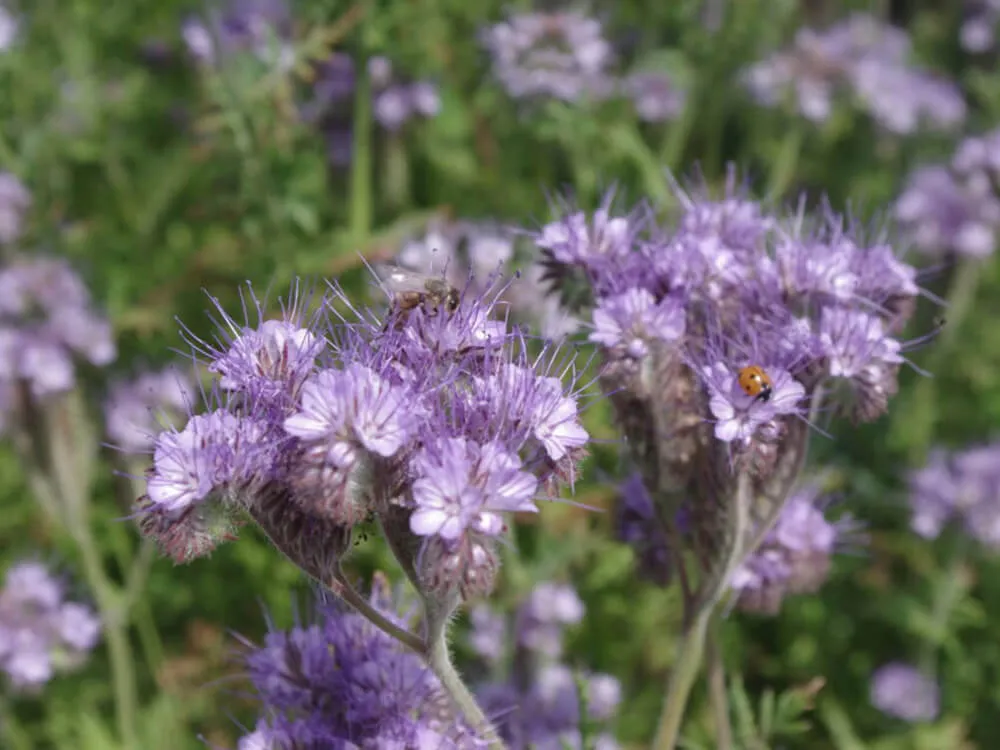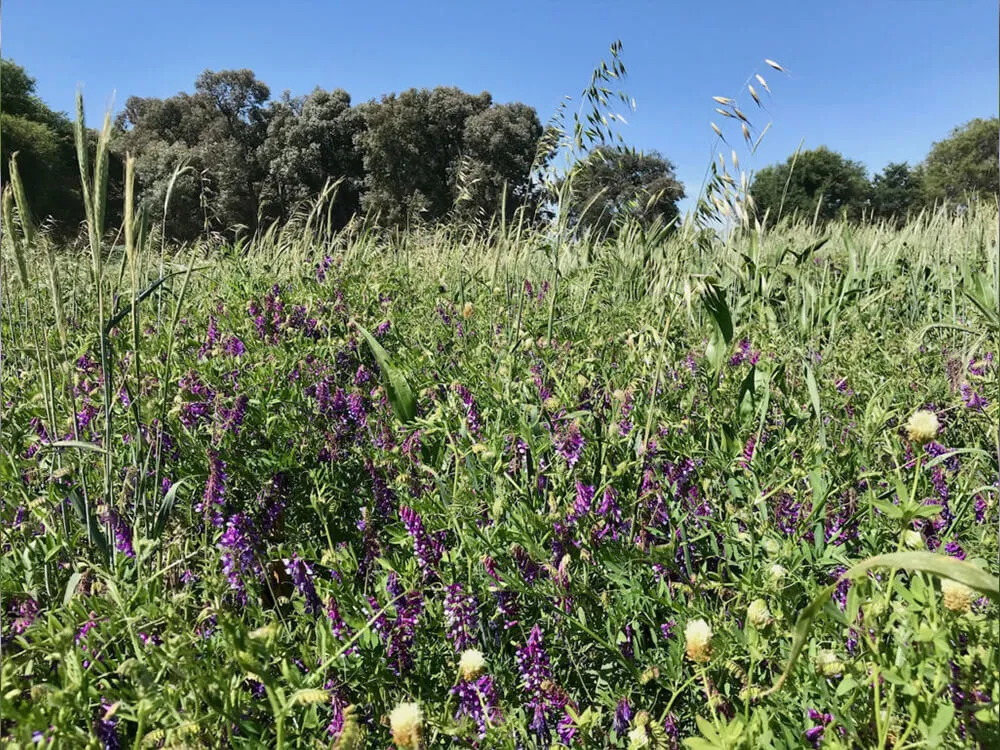





In the fifth episode of the Radio Carbone podcast, we look at the issue of irrigating plant cover crops in arid summer conditions. This is potentially a crucial issue, particularly in the south of France, where repeated failures to establish cover crops have led a number of farmers to abandon them. Soil cover is crucial in these regions, and cover crops planted during intercropping, which is often long, are a key lever for bringing carbon back to the soil and countering the overall drying-out trend.
Nicolas, a farmer in Alpes-de-Haute-Provence (04) involved in the Soil Capital carbon programme, has clearly understood the importance of maximising the development of cover crops for the long-term future of his system. He irrigates his crops, and is wondering whether it would be worthwhile to also apply water to his cover crops. More generally, he wonders about the impact of a productive intercropping cover crop on the total water balance, and is concerned about the risk of competition for water resources between the cover crop and the following crop.
For Benoît Chorro, agronomist and trainer at Icosystème, a productive intercropping cover crop improves the water balance in both the short term (improving infiltration and reducing evaporation losses) and the long term (increasing retention capacity). In the event of prolonged drought, it is therefore useful to apply water to encourage the emergence of cover crops, and competition for water can be avoided by choosing the right date for destruction.
In Mediterranean climates, certain situations are unfavourable for the emergence of cover crops, such as "summer sowing several days after the harvest, which does not benefit from water rising by capillary action". In this context, if you invest around one hundred to one hundred and fifty euros in a cover crop (sowing + seeds), for Benoît Chorro, it is clearly strategic to provide twenty-five to thirty millimetres in order to ensure a return on investment. However, he insists that this amount of water should only be used to get the cover crop to emerge in the event of prolonged drought. After that, storm rainfall is sufficient to meet the plants' needs. Benoit Chorro points out, however, that it is a combination of factors that contribute to achieving the objective of starting a cover crop, i.e. rapid emergence at a good density and good uniformity to avoid dirtying the plots:
*A plant with a particular photosynthesis mechanism adapted to a hot climate, such as sorghum or maize.

Benoît Chorro explains that in dry soils, plant cover increases the effectiveness of rainfall by improving infiltration, and makes better use of water by reducing evaporation. The agronomist also points out that a one per cent increase in organic matter improves the useful reserve (UR) by an average of ten per cent. In the long term, biomass production and the contribution of carbon to the soil are crucial to increasing the soil's retention capacity.
To ensure that the water consumption of the cover crop does not impact on the development of the cash crop, Benoit Chorro stresses that the date of destruction must be the subject of "arbitration based on the needs of the following crop, the weather forecast and the theoretical useful reserve of the soil". Firstly, he insists on the need to observe the soil, and in particular the rooting of the cover crop and the state of structure/moisture. In soils with relatively low useful reserves, such as those in Nicolas, it may be a good idea to destroy the winter cover around three weeks or a month before planting spring crops. In other, more favorable contexts, Benoit Chorro explains that it is possible to sow certain crops directly into existing cover crops, but this requires technical expertise and specific equipment.
For Benoît Chorro, irrigation is an additional tool to ensure the success of cover crops, and must form part of an overall agronomic strategy. What is certain is that maximising soil cover is not at all antagonistic to water availability. On the contrary, the more the soil is covered and the more biomass is produced, the more it will be able to store and infiltrate water. For Benoît Chorro, this demonstrates once again that soil regeneration and production are complementary.


In the fifth episode of the Radio Carbone podcast, we look at the issue of irrigating plant cover crops in arid summer conditions. This is potentially a crucial issue, particularly in the south of France, where repeated failures to establish cover crops have led a number of farmers to abandon them. Soil cover is crucial in these regions, and cover crops planted during intercropping, which is often long, are a key lever for bringing carbon back to the soil and countering the overall drying-out trend.
Nicolas, a farmer in Alpes-de-Haute-Provence (04) involved in the Soil Capital carbon programme, has clearly understood the importance of maximising the development of cover crops for the long-term future of his system. He irrigates his crops, and is wondering whether it would be worthwhile to also apply water to his cover crops. More generally, he wonders about the impact of a productive intercropping cover crop on the total water balance, and is concerned about the risk of competition for water resources between the cover crop and the following crop.
For Benoît Chorro, agronomist and trainer at Icosystème, a productive intercropping cover crop improves the water balance in both the short term (improving infiltration and reducing evaporation losses) and the long term (increasing retention capacity). In the event of prolonged drought, it is therefore useful to apply water to encourage the emergence of cover crops, and competition for water can be avoided by choosing the right date for destruction.
In Mediterranean climates, certain situations are unfavourable for the emergence of cover crops, such as "summer sowing several days after the harvest, which does not benefit from water rising by capillary action". In this context, if you invest around one hundred to one hundred and fifty euros in a cover crop (sowing + seeds), for Benoît Chorro, it is clearly strategic to provide twenty-five to thirty millimetres in order to ensure a return on investment. However, he insists that this amount of water should only be used to get the cover crop to emerge in the event of prolonged drought. After that, storm rainfall is sufficient to meet the plants' needs. Benoit Chorro points out, however, that it is a combination of factors that contribute to achieving the objective of starting a cover crop, i.e. rapid emergence at a good density and good uniformity to avoid dirtying the plots:
*A plant with a particular photosynthesis mechanism adapted to a hot climate, such as sorghum or maize.

Benoît Chorro explains that in dry soils, plant cover increases the effectiveness of rainfall by improving infiltration, and makes better use of water by reducing evaporation. The agronomist also points out that a one per cent increase in organic matter improves the useful reserve (UR) by an average of ten per cent. In the long term, biomass production and the contribution of carbon to the soil are crucial to increasing the soil's retention capacity.
To ensure that the water consumption of the cover crop does not impact on the development of the cash crop, Benoit Chorro stresses that the date of destruction must be the subject of "arbitration based on the needs of the following crop, the weather forecast and the theoretical useful reserve of the soil". Firstly, he insists on the need to observe the soil, and in particular the rooting of the cover crop and the state of structure/moisture. In soils with relatively low useful reserves, such as those in Nicolas, it may be a good idea to destroy the winter cover around three weeks or a month before planting spring crops. In other, more favorable contexts, Benoit Chorro explains that it is possible to sow certain crops directly into existing cover crops, but this requires technical expertise and specific equipment.
For Benoît Chorro, irrigation is an additional tool to ensure the success of cover crops, and must form part of an overall agronomic strategy. What is certain is that maximising soil cover is not at all antagonistic to water availability. On the contrary, the more the soil is covered and the more biomass is produced, the more it will be able to store and infiltrate water. For Benoît Chorro, this demonstrates once again that soil regeneration and production are complementary.
